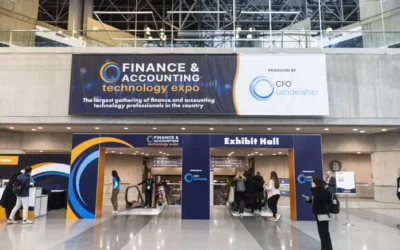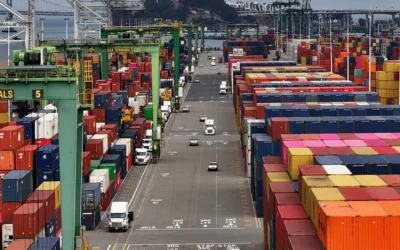Earnings calls, loved by some CFOs and dreaded by others, allow finance leaders and their fellow executives to verbalize their organization’s progress. Each month, CFO.com compiles interesting insights shared by CFOs during these calls for The CFO Earnings Dispatch series. These insights include statements about their company, analysis of financial data and answers to analysts’ questions.
For October, we highlight CFO takes from Amazon, Fiserv, Eli Lilly, Reddit, Carvana, Boeing, JetBlue, Sysco, UPS, Tesla and Heineken.
1. Amazon
Market cap: $2.66 trillion
Date of call: Oct. 30
Amazon reported Q3 under the shadow of a major outage and high-profile, multi-thousand person headcount reduction announced earlier in the week and one day after AWS disclosed a $38 billion multi-year infrastructure deal to run OpenAI workloads on Amazon EC2 UltraServers. The OpenAI partnership will scale through 2026 and 2027 and is intended to give AWS a new marquee proof point in the competition for frontier AI training capacity.
CFO Brian Olsavsky said worldwide revenue was $180.2 billion in Q3, up 12% year over year excluding a 90 basis point favorable impact from foreign exchange. He said worldwide operating income was $17.4 billion, including “two special charges, which reduced operating income by $4.3 billion.” He said excluding those legal and severance charges operating income “would have been $21.7 billion or $1.2 billion above the high end of our guidance range.”
He said North America segment revenue increased 11% year over year to $106.3 billion and that international revenue grew 10% year over year to $40.9 billion excluding foreign exchange effects. He said the regionalized fulfillment network “is operating at scale” and cited “a reduction of U.S. inbound lead time by nearly 4 days compared to last year.”
On cloud offerings, he said AWS revenue rose to $33 billion, up 20.2% year over year, and that AWS operating income was $11.4 billion. He said AWS revenue increased $2.1 billion quarter over quarter while noting depreciation tied to new data center capacity will pressure margins as AI infrastructure comes online. He said full year cash CapEx is expected to be “approximately $125 billion in 2025” and that amount “will increase in 2026.”
2. Fiserv
Market cap: $34.56 billion
Date of call: Oct. 29
Fiserv CFO Paul Todd — who was formally announced on the call as stepping into the CFO role effective Oct. 31 — said the company is now operating off a lower baseline of low-single-digit organic revenue growth in 2026 and only modest EPS compression before re-accelerating in 2027. He acknowledged how harsh that new starting point is landing with investors.
Todd said Q3 adjusted EPS was “$2.04 compared to $2.30 in the prior year, down 11%,” and noted the period included a “$53 million foreign currency expense, or a $0.10 headwind to adjusted EPS.” Argentina’s rate shock alone created “a $31 million” incremental interest expense drag.
He stressed the trough is ahead, not behind the company. “We do trough out on the margin in the first half, particularly in the first quarter,” Todd said, adding full-year margin normalization will happen “roughly” by the end of 2026. He also called 2026 a “critical investment and transition year.”
The comments land into a very different valuation backdrop as shares are down sharply, management has reshuffled leadership roles and the IBM-supported Project Elevate AI program is now positioned as the primary remediation lever. Even so, Todd repeated his long-term conviction: “Fundamentally it’s strong.”
3. Eli Lilly
Market cap: $851.38 billion
Date of call: Oct. 30
Lucas Montarce, CFO of Eli Lilly, said revenue grew 54% year over year and gross margin of revenue reached 83.6% up 1.4 points. He said research and development expense increased 27% and that Lilly has “initiated 16 new phase three programs since the start of 2024.” He noted marketing, selling and administrative expenses rose 31% tied to ongoing and future launches, some of which have been criticized.
He also added that U.S. revenue increased 45% driven by strong volume from Zepan and Mounjaro “partially offset by a 15% decline in price.” Excluding a favorable prior year adjustment “U.S. price declined by high single digits.” he said. Reuters separately reported Lilly and Novo Nordisk are in talks with the White House on a plan that could set a $149 per month price for the lowest dose obesity products in exchange for Medicare coverage.
Looking ahead, Montarce said strong trends supported a higher full year revenue outlook of $63 to $63.5 billion. He said Lilly now expects non-GAAP performance margin to be 45-46% of revenue and raised full year non-GAAP EPS to $23.23-$23.70. “We now anticipate our full-year revenue will be between $63 and $63.5 billion” he said. Outside the quarter, Lilly announced a new $3 billion Netherlands site to expand oral medicine manufacturing capacity.
4. Reddit
Market cap: $35.32 billion
Date of call: Oct. 30
CFO Andrew Vollero said Reddit reached a major profitability milestone in the third quarter as adjusted EBITDA margins hit 40% for the first time. Revenue rose 68% year over year to $585 million, driven by a 74% increase in advertising sales across all verticals and geographies. The company’s recent surge has also pushed the CEO and owner into billionaire territory. “Our net income margin was 28%,” Vollero said, noting incremental adjusted EBITDA margin reached 60% while gross margin stayed above 90% for a fifth consecutive quarter.
Vollero emphasized that operating discipline is sustaining growth without sacrificing profitability. Adjusted operating expenses grew 35%, about half the pace of revenue and mainly from investments in sales and marketing. “We spent about single-digit percent of revenue last quarter. This quarter, we’re kind of low mid-single digits percent of revenue.” he said. “If we find an area that makes sense, we’re not afraid to spend. But if we don’t see the returns, we won’t be putting a ton of money behind it.”
Looking ahead, Vollero said margins will keep expanding as Reddit scales globally. He guided Q4 adjusted EBITDA margins to 42% at the midpoint and pointed to 50% as a new long term “North Star.”
“It won’t be every quarter,” he said. ““And so there may be times that we’ll have to invest in our business periodically. I think right now we’re doing fine and things continue to scale well.”
5. Carvana
Market cap: $68.08 billion
Date of call: Oct. 29
Carvana posted another record quarter with retail units sold up 44% to 150,941 and revenue up 55% to $5.647 billion. CEO Ernie Garcia said the company remains “the most profitable and fastest-growing automotive retailer” and reiterated the goal of selling “3 million cars at a 13.5% adjusted EBITDA margin over the next five to ten years.” Shares have been under pressure even as results set new highs. The company’s financial reporting has also drawn increasing outside scrutiny, with questions around elements of its accounting practices.
CFO Mark Jenkins said loan performance for “2024 and 2025 loan originations are performing extremely well” and pointed to the Ally agreement expansion as validation. He said gains in other GPU reflect “fundamental gains” in finance and BSC attach rates, and that Carvana plans to pass some of those gains back to customers in Q4.
The operational push now expands offline, too, and is stepping into the new car business. Though the shift has caused stir in the market, Car Dealership Guy reported Carvana acquired a second Stellantis CDJR franchise in Dallas as part of early franchise testing. Garcia said “thousands of vehicles can be purchased in minutes and delivered in hours” and noted Phoenix same-day and next-day delivery now reaches 40% of customers versus 10% nationwide.
6. Boeing
Market cap: $151.04 billion
Date of call: Oct. 29
CFO Jay Malave said revenue grew 30% to $23.3 billion driven by higher commercial deliveries and defense volume and noted it was Boeing’s first positive free cash flow quarter since 2023. He said the $4.9 billion 777X charge drove the “$6.45 impact” to core loss per share and said free cash flow of $238 million was “better than expectations in July” helped by the potential DOJ payment shifting to Q4. The quarter unfolded as Boeing manages minimally impactful labor strikes across U.S. facilities and continued legal exposure tied to the Ethiopian MAX crash.
Malave said 2026 will be “a headwind relative to our prior expectations of $2 billion” on 777X cash usage and that usage will be “a little bit higher than that.” He said the path improves steadily over the decade with Boeing “closer to the neutral in 2028” and moving to a benefit “starting in 2029.” He added next year will be “a little bit heavy” as inventory builds and advances and delivery payments remain limited.
Malave added that full year 2026 cash guidance will be updated in January and described the long run cash profile as intact but still being assessed. He said financial performance has “improved throughout the year” and that trends are “bullish,” but he is still reviewing the planning inputs. Analysts have begun to reflect that recovery in their models: Freedom Capital upgraded Boeing stock to Buy from Hold and lifted its price target to $223 citing stronger operational execution and early signs of regulatory momentum.
7. JetBlue
Market cap: $1.48 billion
Date of call: Oct. 28
Ursula Hurley, CFO of JetBlue, said the company ended the quarter with operating margin “three points better than what was implied by our July guidance ranges,” supported by stronger operations, close in demand and tighter cost control. Cost per available seat mile, excluding fuel costs rose 3.7% year over year beating the midpoint of initial guidance by more than one point, and fuel held to $2.49 a gallon in Q3 with Q4 expected between $2.33 and $2.48.
The quarter unfolded during the ongoing government shutdown that has weighed on air traffic control staffing and airline throughput nationally. Some analysts have also floated JetBlue as a potential strategic acquisition target for United given JetBlue’s Northeast footprint and current financial pressure.
Hurley said maintenance will remain a drag as the airline moves through 2026. “Maintenance is still gonna be a headwind next year,” she said. “About half of our fleet is the A320, and that fleet is aging. It is not on a flight hour agreement. It is on a time and material agreement. It is still gonna be a headwind.” She noted the company expects unit cost next year to be “low single digits” supported by new deliveries and returning aircraft.
Hurley said the Jet Forward plan remains on track to hit $290 million of incremental EBIT this year and is intended to build a 2026 plan with breakeven or better operating margin. “We ended the quarter with a healthy liquidity level of $2.9 billion in cash and marketable investments,” she said, adding she believes JetBlue has a path to free cash flow at the culmination of Jet Forward in 2027.
8. Sysco
Market cap: $34.98 billion
Date of call: Oct. 28
CFO Kenny Cheung said Q1 strength at Sysco supports both the full year outlook and the sequential growth set up for Q2. He said the company is seeing “positive total and local U.S. FS volume performance” and reiterated that the company expects “at least 100 basis points” sequential improvement in Q2. That comes as U.S. restaurant menu prices continue to trend higher year over year, driving more volume toward food-away-from-home operators and distributors.
Sysco has historically leaned on large M&A to expand internationally and in specialty center-of-plate categories. Cheung and team will continue this trend, likely looking towards inorganic growth to increase penetration in the U.K. and select U.S. metropolitan markets. Competition in its industry is heating up due to more attractive M&A deals across the business as well.
He added the Q1 beat included a below the line benefit as well, noting “$0.02 was driven by prudent tax planning.”
Cheung said early Q2 indicators remain constructive. He said the company is seeing “continued year-over-year momentum in volume growth rates during the month of October” and added “we are extremely confident in our momentum in our local case growth.”
Outside critics have argued the company’s rapid scale and sourcing standardization has come with uneven product quality across certain categories — pressure Sysco believes it can offset by leaning further into specialty protein and local producer programs.
9. UPS
Market cap: $79.44 billion
Date of call: Oct. 28
UPS cut 48,000 management and operations roles last week in what the company called the next phase of its transformation. The downsizing comes on top of a planned 5.9% general rate increase and multiple surcharge increases set to take effect Dec. 22, including higher residential and additional handling fees.
On the call, UPS said Q3 revenue was $21.4 billion with consolidated operating margin at 10%. CFO Brian Dykes said diluted EPS was $1.74 and that $0.30 of EPS came from a sale leaseback transaction that delivered a $330 million pretax gain. He said the leases were structured so UPS keeps operating those properties and said the gain was not adjusted out of non-GAAP results.
Dykes said U.S. average daily volume was down 12.3% from the Amazon glide-down and lower yielding e-commerce but said domestic margin still expanded. Revenue per piece rose 9.8% year over year which he called the strongest in three years. He said UPS is down more than 16 million operational hours and nearly 34,000 positions year over year, including the voluntary driver separation program.
Looking to Q4, he guided revenue to about $24 billion and operating margin of roughly 11% to 11.5%. He said UPS has “plenty of liquidity to continue executing our strategy.” UPS is watching airline and ATC exposure from the shutdown but is not assuming a hit to operations as a result.
10. Tesla
Market cap: $1.40 trillion
Date of call: Oct. 22
CFO Vaibhav Taneja led Tesla’s earnings call with record free cash flow and incremental margin improvement announcements. He said “Greater China and APAC were up sequentially 33%, North America was up 28%, while (Europe, the Middle East and Africa) was up 25%” and noted automotive margin, excluding credits, “increased marginally from 15% to 15.4%.” Free cash flow was roughly $4 billion and total cash and investments topped $41 billion, but he cautioned that tariffs are starting to sting a bit, saying “the total tariff impacts for Q3 for both businesses were in excess of $400 million, generally split evenly between them.”
CEO Elon Musk continued to frame valuation through autonomy density instead of vehicle units. He said he is “expecting to have no safety drivers in at least large parts of Austin by the end of this year,” called Optimus’ scale “the infinite money glitch” and claimed “AI five chip will be 40 times better than the AI four chip.” He also reiterated he is “100% confident that we can solve unsupervised full self-driving at a safety level much greater than human.”
The $1 trillion governance fight around Musk’s pay now sits over all of this. Norway’s sovereign wealth fund — Tesla’s seventh-largest shareholder — now says it will vote against the plan, citing dilution and key-person risk, and Glass Lewis and ISS have also recommended rejection. The vote comes as Tesla faces post-credit U.S. demand softness and steep year-over-year declines in several European markets, all while Musk publicly tells investors he needs enough voting control to not be removed while building what he calls “a robot army.”
11. Heineken
Market cap: $45.28 billion
Date of call: October 22
Heineken CFO Harold van den Broek said Q3 remained pressured by weaker beer demand in Europe and the Americas, but reiterated that management still expects full year organic operating profit growth at the low end of the 4% to 8% range. “Quarter three was a challenging quarter with macroeconomic volatility persisting compounded by other cyclical factors dampening consumer sentiment,” he said, while noting strong offsets in Africa and Asia.
Van den Broek said the pullback in Brazil and Mexico remains temporary. “We really do firmly believe that what we’re currently seeing in the Americas is cyclical,” he said, adding that the company is more directly linking risk management to macro indicators. “Our risk management has definitely evolved… we’re not only sticking to one fixed plan, but we really have plan A, B and C depending on these lead indicators.” He added that slower shelf rebuild in Europe following retail negotiations is nearly fully behind the company and should normalize by year-end.
The earnings call followed Heineken’s announcement that roughly 400 jobs will be cut at its Amsterdam headquarters as the brewer redesigns certain functions and moves more work into its business services unit. The restructuring is part of the company’s Evergreen 2030 digital transformation program. Heineken also recently appeared as a corporate case study in an analysis of companies with science-based climate targets, which found that such disclosures meaningfully improved reputational outcomes and investor confidence.





